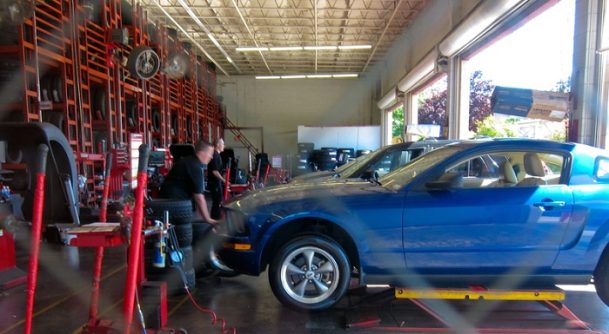Power steering is a vital function in modern vehicles. As it reduces the overall effort needed to turn the wheel, this function makes it easier to turn at low speeds and negotiate tight spaces. Maneuverability is compromised when your power steering experiences a fault or failure, but how much will you need to spend to fix it? This short guide explains the cost of power steering repair and reveals other key details you need to know.

Table of Contents
Dependent on the Specific Issue at Hand
You cannot estimate power steering repair costs without knowing the root causes of failure. While a faulty power steering pump is the most common issue, others include low or contaminated fluid, loose or faulty hoses, and damaged power steering belts. These issues can produce a wide range of symptoms:
- Difficulty steering: Trying to turn the steering wheel may require extreme effort.
- Fluid leaks: Red or brown puddles under your vehicle can signal unexpected steering fluid discharge.
- Grinding or whining sounds: Unusual noises can come from the power steering pump due to low fluid or faulty interior components.
- Inconsistent functioning: Lack of constant steering assistance can indicate a problem or imminent failure.
You must not only factor in the prices of needed replacement car parts but also consider labor costs. With parts and labor, your total cost could range between $200 and $1,500, depending on the precise nature of the problem.
Factors Affecting Power Steering Repair Costs
Several factors can influence the total cost of power steering repairs:
1. Location: Repair costs can vary significantly based on geographic location. Urban areas tend to have higher labor rates than rural areas.
2. Vehicle Age and Condition: Older vehicles may require more extensive repairs due to wear and tear, leading to higher costs.
3. Complexity of the Repair: Some repairs may be straightforward, while others might require significant disassembly of the vehicle, increasing labor time and costs.
4. Type of Repair Shop: Dealerships may charge more for repairs compared to independent shops or mobile mechanics.
How To Avoid More Costly Repairs in the Future
While repairs can be expensive, you can avoid them taking a major bite out of your bank account in the future. Proper care goes a long way toward extending your power steering system’s lifespan. You can easily maintain your system with a few simple practices:
- Check your power steering fluid at least four times annually — or once monthly, if you’re a frequent high-mileage driver.
- Inspect the rubber rack steer boots regularly and look for tears, which can allow debris and moisture into the system.
- Keep your battery charged to avoid power loss that could potentially damage your power steering system.
- Inspect drive and power steering belts and replace them if worn, loose, or exhibiting cracks or tears.
Smart driving is also vital to maintaining an EPS. Avoid steering while stationary, driving through puddles, and forced steering, especially anything that results in extreme sudden movements or pushing your wheel to its turning limits.
Where To Buy Your Parts
Power steering is a ubiquitous feature in modern vehicles. Like other components and systems, it contributes to overall handling, safety, and performance. It’s just one measure for judging Ford F150 reliability, especially if you purchase a pre-owned model. Many F150s have no EPS issues, but some concerns have been reported for the 2011 and 2012 model years.
No matter what type of vehicle you own, where you buy your parts matters just as much as what you buy. Retailers such as PartsHawk offer extensive inventories with large distribution networks and solid expertise — all of which help you quickly obtain high-quality parts to complete any repair, upgrade, or maintenance project.
Conclusion
Power steering repairs can range from minor fixes to significant replacements, impacting the overall cost. Understanding the average costs associated with these repairs, as well as the factors that influence pricing, can help vehicle owners make informed decisions. Regular maintenance and timely repairs can prevent more extensive damage and higher costs in the long run. If you suspect an issue with your power steering system, it is advisable to consult a qualified mechanic to diagnose and address the problem promptly.
Frequently Asked Questions
Q1. Can I drive my car if the power steering pump goes out?
While it may be possible to drive a car with a failing power steering pump, it is not advisable. The steering will become significantly harder, making it difficult to maneuver, especially at low speeds. This can pose a safety risk, particularly when parking or making tight turns.
Q2. Is fixing power steering expensive?
The cost of fixing power steering can vary widely. Simple issues like a fluid leak may be inexpensive to repair, while a complete pump replacement can be costly. On average, expect to pay between £180 and £500 for pump replacement.
Q3. How long does it take a mechanic to replace a power steering pump?
Typically, a certified mechanic can replace a power steering pump in 2 to 3 hours. The exact time may vary based on the vehicle’s make and model and the complexity of the repair.
Q4. Can you still steer if your power steering pump is broken?
Yes, you can still steer a vehicle with a broken power steering pump, but it will require significantly more effort. The steering will feel heavy, making it difficult to control the vehicle, which can be dangerous.
Q5. Can I carry out a power steering pump replacement myself?
Replacing a power steering pump is a complex task that requires mechanical knowledge and specific tools. While it is possible for someone with experience to do it themselves, it is generally recommended to have a professional mechanic handle the repair to ensure it is done correctly.




